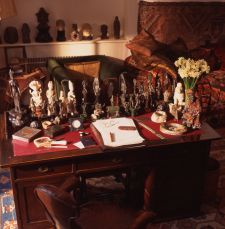My camera is really really old in terms of digital cameras. Because it was built at a time when there wasn't really a standard size for cards or cables, I haven't been able to fit it into anything I've gotten or borrowed. And since I believe my cable is back home, my pictures will have to wait. This sucks because the London Eye had alot of personal pictures I took, but I'll have to use google images for now, and any personal pictures from other people's facebook albums. This is why it took a long time to publish this post.
Thursday began with a field trip to Sigmund Freud's London house.
Born in Austria, Freud developed a method of therapy called psychoanalysis. He worked hard to develop theories to explain our unconscious, the layers of the mind that lay underneath our consciousness.
 |
| Freud believed our conscious mind was just a small piece of our mind, similar to how the part of an iceberg visible above water is just a small piece of the behemoth beneath. |
Believing that most human experiences and energy are derived from the libido, he deduced that most of one's problems were ultimately connected to sex.
He also believed that the interpretation of dreams were methods to discover one's unconscious worries or desires. Although most of his theories have no support today, his development of psychoanalysis eventually led to modern psychology today. He was also known to support the use of cocaine for anesthetic use, and was a recreational user, but the museum left those details out.
Although Freud lived most of his life in Austria, he was also a Jew during World War II. When Hitler annexed Austria in 1938, Freud was forced to flee to England with his family. He moved to a house in London, where he lived the rest of his life until he died in 1939. It is still filled with many of Freud's original possessions, and often reflect his personal work. Strange paintings and pictures decorate his walls, some with a highly graphic sexual scene. Freud himself was a collector of antiquities, and his office and study are lined with relics taken from Egypt, Asia, and the Mediterranean. His desk was literally covered with small figurines of mythical gods from various religions, and several busts were scattered through his room.
 |
| Freud's desk, covered with small deities. |
His infamous reclining coach, a common symbol of therapy, lay along a wall, with his chair sitting next to it's head.
An audioguide and video gave us an interesting tour of his house, and it was awesome to walk through the footsteps of such an important man, even if I thought he was insane.
After our tour, we were free for the day, so we decided to take a bus to nearby Regent Park. Like most large cities, London has several large parks, and Regents is one of the largest. Walking past it's walls lead to a beautiful park, with trees scattered about green grass.
A series of lakes nearby held a population of ducks, while people paddled around in tiny boats.
Walking out from this lead to green fields setup to host a variety of sports, and further on was the London Zoo. People of all sorts were out enjoying the day, and we happily wandered through the park, exploring whatever we fancied at the moment.
At a certain point we traveled to Queen Mary's Garden, filled with lush flowers, with a fountain in the circle.
There was also an open air theater one could buy tickets for during the summer. At a certain point, we bought sandwiches and ate them on the grass, watching as people walked dogs and played with small children. But as time passed on, dark clouds formed overhead and began to shower us, an obvious signal that it was time to return home.
After resting in the dorm, we decided that we wanted to see if a nearby pier hosted evening boat rides up and down the Thames. After walking to pier, we found out that the service was closed for the night, but just across the nearby bridge was the London Eye, which at a whim we decided to visit. This giant Ferris wheel was installed in 2000 as a temporary addition to London for the new Millennium, but grew to be so popular it eventually became permanent.
At 443 feet, this behemoth is one and a half times taller than the Statue of Liberty including her pedestal and foundation. 32 glass capsules rotate slowly around it's circumference, taking thirty minutes to complete one revolution. After buying our tickets, we jumped onto our capsule. It moves slowly enough that it doesn't even need to stop; one can calmly walk onboard.
The height of this ride is so impressive it makes for fantastic picture opportunities for all of London. One can view the entire skyline, including Westminster Abby, the Parliament building, bits of Buckingham Palace, and everything else in the London skyline.
 |
| A view inside a nearby capsule to show what they look like. For some reason there is a car in this one. |
 |
| Parliament Building and Big Ben. |
We got tons of fantastic pictures, most of which I can't show you.
 |
| From the person on the right's album. |
Our timing was perfect as well; we got the second to last capsule before the ride was closed, so as we took pictures, the sun set over London, and the city began to light up. Needless to say, it was pretty awesome.
Having walked an excessive amount this day, we walked back to our flat, passing multiple groups of people who had obviously already hit the pub that evening, though we decided to call it a night.








No comments:
Post a Comment